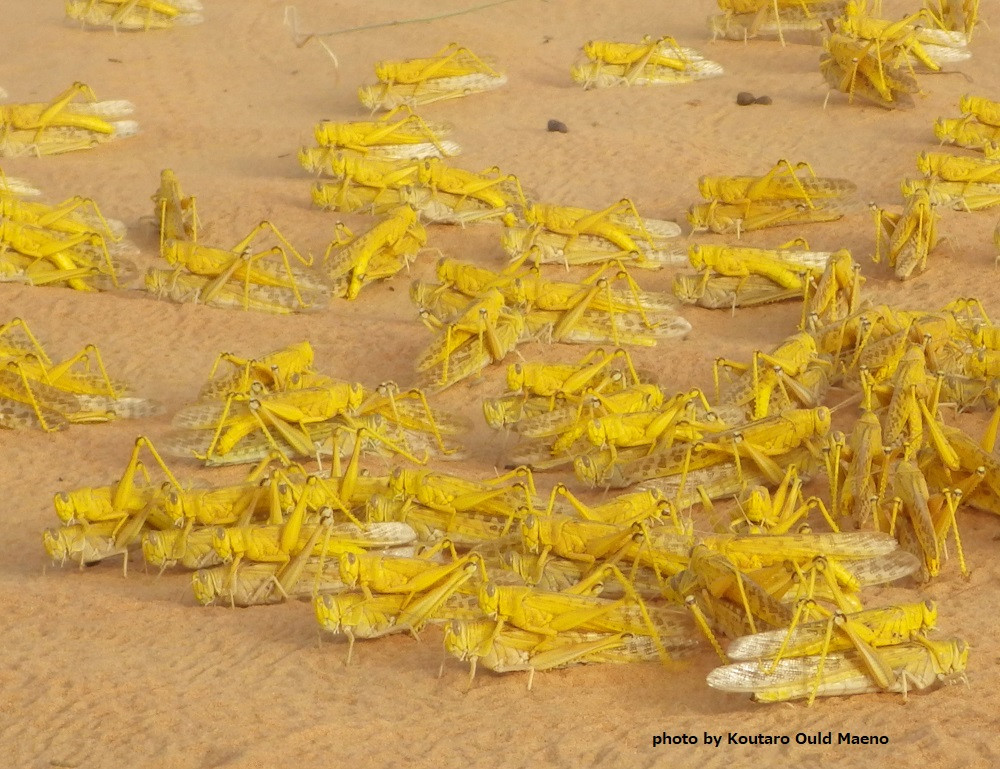Pick Up
401. Elucidating the Unique Reproductive Behavior of Desert Locust Leads to Reduction in Use of Pesticides

Desert locusts, which are found in semi-arid regions from West Africa to India, often aggregate in large numbers and cause serious agricultural damage. Large outbreaks in East Africa and South Asia, and serious agricultural damage have been reported in 2020-2021. Desert locusts are found in vast areas, and it is difficult to control them by spraying pesticides, especially since the adults fly long distances. In order to mitigate the damage caused by desert locusts, JIRCAS is conducting research to develop efficient control technologies based on the ecology of desert locusts from the 4th Medium to Long-term Plan (FY2016-2020, Pest and disease control) to the 5th Medium to Long-term Plan (FY2021-2025, Transboundary pest management). In previous Pick Up articles, we have discussed the significance and direction of the development of desert locust control technology, and introduced a paper on climate change and desert locust outbreaks in East Africa, and a paper on COVID-19 and scenario analysis of desert locusts' impact on the global food market. In this article, we will introduce the results of the JIRCAS research on the reproductive behavior of desert locusts, which can lead to a reduction in the use of pesticides.
This research was conducted in collaboration with the Mauritanian National Desert Locust Centre (CNLA), the French Agricultural Research Center for International Development (CIRAD), and the National Centre for Locust Control of Morocco (CNLAA). As a result of field surveys in the Sahara Desert, sexually mature locust adults formed populations with a skewed sex ratio towards females and males. In the female-biased population, most of the females were developing ovaries and did not mate. On the other hand, in the male-biased population, the females had ripe ovaries just before oviposition, and most of them were mating. Detailed investigation revealed that females just before oviposition flew to the male group during the day, mated, and laid eggs in pairs at night. When desert locusts are mating, the male mounts on the female's back so that the female cannot fly away and is easily attacked by birds and other natural enemies. When males and females live together, the males harass the females to mate, so it is thought that the females avoid mating by living separately from the males while their ovaries are developing, and only lay eggs when they are guarded by the males to ensure safety. It can be inferred that females and males living separately in groups are able to meet their partners efficiently while resolving conflicts between males and females. From the above results, it is clear that it is more efficient to control pairs during the night when they are laying eggs in groups, rather than immediately after finding a group of males during the day. The application of the desert locust ecology is expected to lead to environmentally and health-conscious pest control that does not require the use of more pesticides than necessary.
The Ministry of Agriculture, Forestry and Fisheries (MAFF) has formulated the Strategy for Sustainable Food Systems, MeaDRI to achieve both productivity improvement and sustainability of food, agriculture, forestry and fisheries through innovation. The strategy calls for reducing the environmental burden by reducing the use of chemical pesticides. In this research, we have obtained results that contribute to the reduction of chemical pesticides used for the control of desert locusts. JIRCAS will continue to promote the development of environment-friendly control methods for transboundary pests such as desert locusts, which have become a major problem worldwide
References
Maeno, K.O., Piou, C., Ould Ely, S., Ould Mohamed, S., Jaavar,M.E.H., Ghaout, S. and Ould Babah Ebbe, M.A.Density-dependent mating behaviors reduce mating harassment in locusts (2021) PNAS. https://doi.org/10.1073/pnas.2104673118
JIRCAS Press Release (Oct 12, 2021): Elucidation of the Unique Reproductive Behavior of Desert Locust- Efficient pest control that can lead to reduction in use of pesticides - https://www.jircas.go.jp/en/release/2021/press202110
Contributors: MAENO Kotaro (Crop, Livestock and Environment Division), KOBORI Youichi (Crop, Livestock and Environment Division), NAKASHIMA Kazuo (Director, Food Program)
